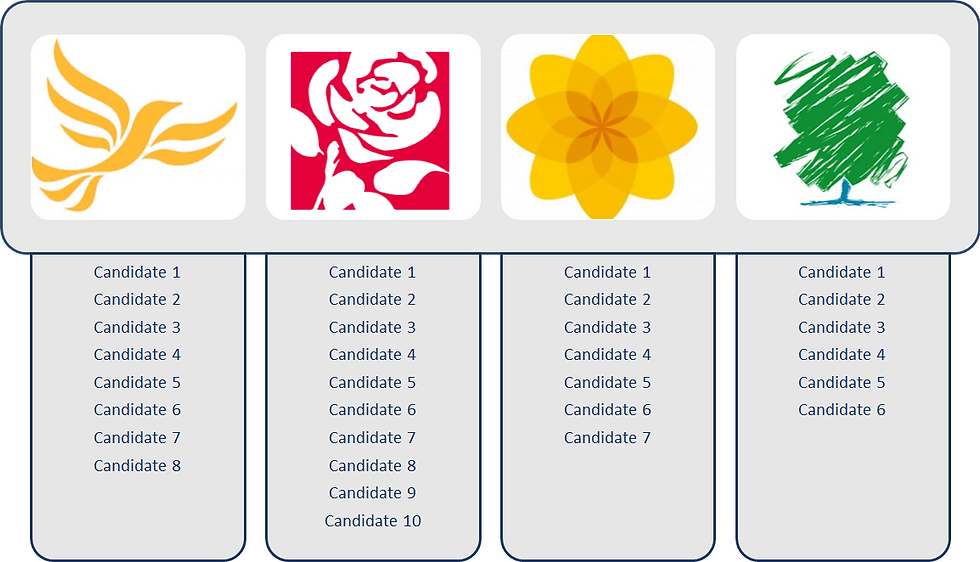Wales's Choice: the intended consequences of electoral systems
- Larissa Peixoto Gomes
- Feb 10, 2024
- 5 min read
Updated: May 7

It has been a few years since Wales starting debating a change of its electoral system, despite the fact that the current one was established in the late 90's. In 2017, the Expert Panel on Electoral Reform delivered its report, already suggesting more members for the Senedd (then Assembly) and more proportionality in the election of those members.
But those points are only now coming up for reform, with great debate due to differing opinions on the need for more members and the different consequences of each option for electing them, both in the voters' freedom of choice and in the proportionality of the outcome.

Proportionality
It is a bit annoying that it's assumed people will just know what proportionality will mean. In the Welsh case, the way is being discussed is that the number of Senedd Members elected for each party will be relative to the number of votes they get. No longer will there be a single member elected for a constituency based on the simple majority of votes.
Currently, it is likely that the Senedd will have 96 members, divided across 16 constituencies, with 6 members each. These will be based of the current 32 constituencies defined by the Boundary Commission for the House of Commons. This means that unlike other countries, there won't be a geographical proportionality, that is, a more populous area having more representatives than a less populated area. This is relevant because for the city of Cardiff alone the population is above 360,000, which can be three times as large as other areas in Wales. But there number of representatives will be the same.
Well, then, how could these six members become elected? First, there are formulas established to make these proportional, but I will be focussing on the actual voting process. The government is supporting a closed-list system, which is being criticised for centralising power in parties and not giving freedom of choice to voters. Let's have a look.
Closed-list system
The closed list system means you vote for the party, not for a person. It discourages candidates from the same party from competing with each other, since the incentive is for more votes for the party so they can get all the seats. It is also claimed that it would lead to a cohesive party platform, as voters would be choosing based on what the party would do, not an individual person.
The critique is that voters don't get to decide the order of that list; it is defined within the party and this can lead to small groups in the parties having a lot of control over that order. If the party predicts that only one or two candidates will actually become elected, than they might not risk putting minority candidates at the top, for example.
One argument I would say is that, for the Welsh voter, this isn't that different from what they have/do now. Welsh voters tend to be loyal to their parties and will vote for them no matter who is on the ballot - or who is at the top of the ballot for that matter.
The image below shows what this could look like.
Closed-list ballot example
Then again, with rules in place to ensure diversity, the closed-list system has had success in other countries in achieving, in particular, gender parity or at least an increase in the number of elected women. This is done by enforcing a rule that men and women need to be placed on the list in particular places, often one after the other, like the image below.
Closed-list system for gender parity
Single Transferable Vote
The option from most experts, including the ones who wrote the 2017 report and the Independent Commission on the Constitutional Future of Wales is the Single Transferable Vote or STV, which would allow voters to change the order of the list. This, ultimately, gives voters two votes - one for the party and one for one or more candidates on that list.
The most common ways of doing this is either signaling who the voter would prefer as first place or reordering the whole list. If those choices are made by enough voters, then it becomes cemented in the election.
While it returns the freedom to choose an individual representative to the voter, it also might reinforce competition within the party, as candidates will compete against each other so that voters will move them up on the list. This could lead to divergences from the party platform and internal splits. It also more complex both for voters and for the Electoral Commission to count these votes, as they are still done on paper ballots. See the image below on what a reorded list could look like (note that while all main parties are pictured, a voter would pick a single party).
Single Transferable Vote example (full list reorder)
Open-list system
The open-list system is not being discussed at all in Wales, but I would be remiss if I didn't talk about it. An open list means there is no order at all from the party and voters would again, in practice, have a vote that would count for the party and for the candidate. In a nutshell, the order of the list is decided after the election. Voters would still have the option to vote just for the party, but that means they would forfeit their choice in representative. This option again reinforces internal party competition.
This system tends to work well for smaller countries, although counting the paper ballots would take a little longer as well. In addition, while for the examples above I limited the lists to six candidates, because the open list means that voters can choose anybody on it, and all votes count proportionally for the party, in the example below I didn't set the six member limit.
Arguably, only the closed-list system would require that parties limit their offering to six candidates, since STV enables voters to move a candidate from position 7 to position 1; however, it would indicate that the party had no intention of placing that candidate in an electable position.
Open-list system example
A more proportional system would lead to a greater diversity in parties in the Senedd. For Welsh voters, this would mean having six rather than five SMs (although a lot believe their representative is the single one elected by first-past-the-post). It will be a cultural shift to finally come to grips with the fact that all the elected candidates from your constituency represent you, even the ones you didn't vote for.
I realise that very few people look at countries changing their electoral systems and go YAY FUN like I do, so I hope this brief explainer helps a few in understanding why politicians are fighting over these choices and what they'll be doing in the polling station in the coming years. Because yes, voting for the Senedd is incredibly important and should not be taken for granted.








Comments